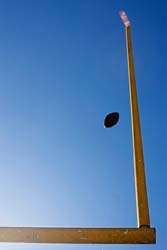NCAA News Archive - 2008
« back to 2008 | Back to NCAA News Archive Index
|
The NCAA News
The Division I Football Academic Working Group at its first meeting July 18 in Indianapolis reviewed data from the NCAA research staff showing that incoming freshmen in the sport have lower high school grades and standardized test scores than any other group except for men’s basketball.
However, during their freshmen year, football student-athletes have lower grade-point averages, fewer credits earned and lower eligibility rates than their men’s basketball counterparts.
That is an example of the academic factors in football that the working group will identify and attempt to rectify during its examination of the academic performance in the sport at the Division I level.
Joe Castiglione, the director of athletics at Oklahoma, is chairing the diverse group that includes presidents, coaches, faculty athletics representatives, conference commissioners and athletics directors from the Football Bowl and Football Championship subdivisions. American Football Coaches Association Executive Director Grant Teaff is also a member of the working group.
“Everyone sitting around the table represents all of the interests in our membership,” Castiglione said. “It is very important for us to provide the opportunity for every item to be brought forward for consideration. At the end of the day, we don’t want anyone to say, ‘You didn’t consider something, or an issue wasn’t discussed.’ ”
NCAA President Myles Brand encouraged the group to do some high-altitude thinking. He also encouraged members to find solutions specific to the FBS and the FCS if necessary.
“I appreciate (Brand) eliminating any boundaries,” Castiglione said. “That has energized our group immensely. Every one of our working group has a passion for academic reform in general. We’re trying to find the best way and most appropriate means possible to be successful.”
The working group established subcommittees that will address eligibility, retention and finance matters in both subdivisions. Each held conference calls in May to begin their work.
Like the Baseball Academic Enhancement Group that convened in 2006-07 and the group that began looking at APR issues in men’s basketball in August of 2007, the football working group’s first meeting centered on identifying factors unique to football that affect academic success.
The research on the 0-for-2 student-athletes – those who lose both the eligibility and retention points in an academic year – showed a trend in which FBS student-athletes are most likely to become 0-for-2s as they exhaust their athletics eligibility. Such student-athletes composed 13 percent of all 0-for-2s in the FBS in 2006-07. Two-year transfers into FBS programs became 0-for-2s more than 18 percent of the time when they exhaust eligibility.
Two-year transfers into FBS programs also lose an eligibility point during their first term of enrollment 27 percent of the time.
Football’s low APR numbers show that these student-athletes are taking the minimum amount of credits to remain eligible. If they slip up in just one class, they get into trouble academically.
In the FCS, the first year is the time when football student-athletes are most likely to become 0-for-2s, although there is significant loss at the end of athletics eligibility at this level as well.
Four-year transfers into FCS programs are at a high risk (more than 12 percent) of becoming 0-for-2s in their first year.
The 2006-07 data revealed that freshmen entering the FCS are at a risk (about 7 percent) of becoming 0-for-2s by the end of their first year.
APR problems for both subdivisions tend to be because of eligibility rather than retention issues.
The eligibility setbacks show those student-athletes who become first-term 1-for-2s dig a hole academically. The 1-for-2s in this group show a GPA of 1.13 compared to 2.56 for football student-athletes who maintain their eligibility.
Those who lose an eligibility point earn an average of 6.4 credits in the first term compared to 12.2 credits earned by those who do earn the eligibility point.
The research shows that 81 percent of FBS student-athletes go to summer school, while 38 percent in FCS attend classes in the summer.
Rather than using summer school as a way to make up lost ground academically, the working group wants to figure out how to get student-athletes off to a better start in the classroom.
One idea the group considered was to require student-athletes to be academically eligible in the fall term in order to participate in spring practice of that academic year.
Working-group members also said they would review a five-year eligibility model for football student-athletes that would eliminate redshirting. Some members believe that might help student-athletes psychologically, knowing that they may have a chance to appear in a game as opposed to practicing all year with no chance of playing in a game that season.
The group also discussed an academic year of residence for two- and four-year transfers.
Financial variables are also being examined. There is some correlation between APR and athletics department expenditures, but a more important factor is the academic profile of the incoming student-athletes – If academically unprepared high school students or 2-4 transfers are brought in, it is likely the program’s APR will suffer, regardless of the financial resources devoted to those students.
The working group will conduct several conference calls in the coming months to discuss possible outcomes that will aid APR numbers. Its next in-person meeting will be after January 1, 2009.

